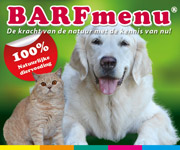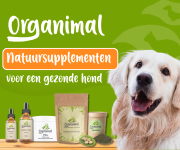YvesT schreef:Sorry laat thuis vandaag.
Deze morgen en vanavond geprobeerd met duck pancreas.
Maar hij had er geen interesse in.
Van de DA hadden we nog een telefoontje gehad. Zijn alvleesklier waarde moest onder de 200 zijn en was 500.
Dus daar zit ie een stukje over. De maagzuur pillen en anti-braak pillen moet ik nog blijven geven.
Voor de rest moest ik zijn eten zo vetvrij mogelijk houden.
Wat me dan eigenlijk de vraag doet stellen. Is duck pancreas dan wel goed? Want ik zie op de verpakking toch staan dat hier iets van een 10% vet in zit.
Ja. Misschien wel. En daarbij lust hij het dus ook niet. Ik weet niet hoe je Engels is? Hier staat hoe je uit kunt rekenen wat het werkelijke vetpercentage is in de voeding:
https://www.whole-dog-journal.com/issue ... 088-1.html. Volgens mij moet je dan alleen het aantal kcal weten in Duck en dat zie ik zo gauw niet op de website staan. Misschien staat het op de verpakking? Of kun je Duck even bellen?
Maar als je hond die vieze brokjes niet lust en je kan geen Duck voeren: dan ben ik bang dat je nog maar 1 ding kunt doen: zelf de voeding voor je hond gaan samenstellen. Dan voer je smakelijk eten en heb je het vet aandeel zelf in de hand.
Helaas is het Internet 1 groot woud van tegenstrijdige adviezen. De een zegt; geen rauw vlees voeren en de volgende zegt juist van wel. De ene zegt; voor de helft koolhydraat en voor de andere helft mager vlees voeren en de volgende zegt weer : "geen koolhydraat voeren". En beide kampen daar zitten mensen in waar ik normaal gesproken echt veel vertrouwen in heb vanwege hun kennis (dierenarts Ian Billinghurst, Mary Strauss, etc).
Ik val toch terug op wat ik in 2014 een keer eerder vertaald heb voor iemand omdat ik denk dat dit het meest veilige advies is (oud topic is deze:
viewtopic.php?f=11&t=122566&p=2930850&h ... g#p2930850):
What to feed in the beginning
The goal in the beginning is to feed a diet with low fat, moderate protein, and high carbohydrates, as carbs cause the least amount of pancreatic stimulation. An easy diet to start with is overcooked white rice made with extra water, combined with a low-fat protein source, such as cooked chicken breast, low-fat cottage cheese, or boiled hamburger (boiling removes most of the fat).
Noot Lizzy: Hier staat: en als je dan zelfgemaakt voer wil geven: begin met een voer dat laag in vet is, gemiddeld in eiwit en hoog in koolhydraat, aangezien koolhydraat de pancreas niet stimuleert. Gekookte witte rijst (dat je langer kookt dan normaal) is een prima begin. Daar geef je dan bij wat gekookte kipfilet, huttekase, gekookte hamburger (koken verwijderd het meeste vet - dat schep je er ook vanaf).
Even if you normally feed a raw diet, the meat should be cooked for now, to remove fat and to destroy bacteria that can be problematic if the intestines have been damaged. Cooking or warming food usually makes it more appealing as well. Bones should not be fed at this time. Offer food at room or body temperature, as cold food takes longer to digest.
Noot Lizzy:Hier staat: ook als je normaal gesproken een rauw voer voert, het vlees moet vanaf nu gekookt worden om het vet te verwijderen en om alle bacteriën te doden die eventueel voor problemen kunnen zorgen. Gekookte voeding is voor de hond ook aantrekkelijk om te eten en aangezien ze toch al vaak zo rot eten, is koken dus hier een prima idee. Vleesbot voer je nu niet. Geef het voer op kamer of lichaamstemperatuur, niet koud, dat verteerd slecht.
If possible, choose foods your dog has had before – ones you know agree with him and that he likes. White rice is the preferred carbohydrate choice, as it is easiest to digest, but you could use potatoes or sweet potatoes instead if you need to avoid rice due to allergies or intolerance (remove the skins to reduce fiber in the beginning).
Noot Lizzy: Hier staat dat je het beste witte rijst geeft, maar dat je ook aardappel of zoete aardappel kunt geven als je hond allergisch is voor rijst. Je moet de aardappels/zoete aardappels schillen, want in het begin moet je niet teveel vezel geven.
Overcooking starchy foods such as rice or potatoes increases their digestibility. Cooking white rice with extra water creates a type of porridge called rice congee, which is soothing to the stomach and digestive tract, and can help relieve vomiting and diarrhea. To make congee, boil one cup of white rice (not Minute Rice) in four cups of water for 20 to 30 minutes. You can offer the rice congee liquid alone to start with, then include the rice, and next add the protein. This progression can happen over the course of a few hours or a day or two.
Noot Lizzy: je kookt het in eerste instantie dus langer dan normaal, dat verbeterd de verteerbaarheid. Je voegt ook extra water toe, dan krijg je een beetje een dik papje.
At first, feed a higher percentage of carbohydrates, and a lower percentage of protein, such as two-thirds carbs and one-third protein. If your dog is doing fine, the ratio can then be slowly changed to half and half after the first few days.
Noot Lizzy: Hier staat dus dat je eerst 2/3 koolhydraat geeft, 1/3 eiwit. Als je hond het hier goed op doet, verander je dat naar 50% koolhydraat en 50% eiwit (nog steeds rijst en gekookte kip/hamburger/zeer mager rundvlees). Als je mijn mening wilt weten: dan zou ik gelijk beginnen (in jouw geval) met 50% koolhydraat en 50% mager vlees.
Whatever you feed, start with small amounts fed frequently, six to eight meals a day or more. Small meals stimulate the pancreas less, and are less likely to trigger vomiting. Small meals are also easier to digest than larger meals, and less likely to cause discomfort. If your dog is able to keep the food down without vomiting or showing signs of pain, you can begin to feed larger amounts at longer intervals, but proceed slowly, especially in the beginning; you don’t want to make changes too quickly and end up with a setback.
Noot Lizzy: Hier staat: wat je ook voert, voer 6 tot 8 maaltijden per dag of meer. Kleine maaltijden stimuleert de pancreas minder en zorgt ook dat je hond minder snel overgeeft. Het is ook makkelijker verteerbaar, een kleine maaltijd. Als je hond dit voer binnen houdt en hij weinig pijn toont, kun je wat langere periodes tussen de maaltijden laten zitten maar doet dat langzaam! Als je te snel gaat, valt je hond mogelijk terug.
Contact your vet for advice if your dog vomits. You will probably need to stop feeding again briefly (12 to 24 hours), then start over by introducing water and progressing to bland foods again. Your dog may also need anti-vomiting medication.
It is not necessary for your dog’s diet to be “complete and balanced” in the short term; an adult dog will do fine on an incomplete diet for a few days to a few weeks. Start with a very simple diet, and then add more ingredients as your dog recovers and you see he is doing well.
Noot Lizzy: Het geeft niks dat je niet compleet voert, je hond kan daar prima tegen voor een paar weken. Houd je dieet simpel. Het is beter om, als het beter gaat met je hond, langzaam dingen toe te voegen en te kijken hoe ie het daar op doet.
Transitioning to a normal diet
Once a dog has had an attack of acute pancreatitis, he may be less able to tolerate fat in the future, depending on how much the pancreas was damaged. Some dogs are able to return to a normal diet after they have fully recovered, while others may need a low-fat diet for the rest of their lives to prevent chronic pancreatitis and further acute episodes.
Noot Lizzy: Hier staat dat na een acute alvleesklierontsteking de meeste honden de rest van hun leven minder goed tegen vet kunnen. Het is afhankelijk van hoe ernstig de alvleesklier beschadigd is. Sommige kunnen volledig terug op hun oude menu. Anderen moeten de rest van hun leven op een voedsel blijven dat laag is in vet gehalte. Honden die wederom een alvleesklierontsteking ontwikkelen, moeten op een vet arm dieet blijven.
Dogs who experience a single, acute, uncomplicated episode are more likely to be able to return to a normal diet, while dogs with repeated episodes of acute pancreatitis, hyperlipidemia, or steatorrhea (large, greasy, foul-smelling stools caused by fat malabsorption) should be kept on a fat-restricted diet.
Dogs with chronic pancreatitis may also do better on a lower-fat diet. Drugs that predispose dogs to pancreatitis should be avoided if possible in these dogs. If such drugs are needed, e.g., to control seizures, these dogs, too, may benefit from a low-fat diet. Dogs who have had acute pancreatitis should never be fed really high-fat meals, even if they are able to return to a normal diet afterwards.
Continue to feed a low-fat diet with moderate protein for at least 7 to 10 days or longer, depending on the speed of your dog’s recovery and the severity of the episode. Gradually increase the size of each meal and the time between meals until your dog is eating two or three meals a day.
Noot Lizzy: Hier staat dat je tenminste 7 tot 10 dagen een dieet moet voeren dat laag is in vet en gemiddeld in eiwit. Daarna kun je heel langzaam minder maaltijden per dag gaan voeren, tot je er weer 2 of 3 per dag geeft.
If your dog is doing well and showing no sign of discomfort after eating, you can then begin to gradually increase the amount of fat in the diet. Begin adding small amounts of his regular food back into his diet. If the diet he was eating before was high in fat, try feeding foods with a moderate amount of fat to start with, though you may eventually be able to transition back to somewhat higher-fat foods if your dog gets a lot of exercise, is lean rather than overweight, and you have reason to believe that something other than diet caused the acute pancreatitis.
Noot Lizzy: Hier staat dat als je hond het goed doet en hij geen pijn heeft of zich naar voelt na het eten, dat je dan heel langzaam weer wat meer vet kunt gaan voeren. Begin met een klein beetje voedsel te geven dat hij normaal ook at. En schakel zo langzaam over op je oude dieet. Zorg dat je hond eventueel overgewicht kwijt raakt.
Remember that lower-fat diets provide fewer calories, so the total amount you feed will need to be increased when you reduce the amount of fat in the diet. The increase will depend on how much fat was in your dog’s previous diet. If possible, determine how many calories your dog was getting before and try to match that with the new diet (or moderately decrease the calories, if your dog is overweight). Weigh your dog frequently and then adjust the amount you are feeding up or down as needed to maintain proper weight. If your dog lost weight due to acute pancreatitis, don’t try to put the pounds back on too quickly; slow and gradual weight gain or loss is healthier than trying to make large changes in a short period of time.
Noot Lizzy: Hier staat dat je in de gaten moet houden dat een vet-arm dieet minder calorieen bevat. Je moet dus meer gaan voeren van, wanneer je hond vet-arm eet/moet blijven eten.
Keep a close eye on your dog, particularly after meals, watching for signs of discomfort such as a hunched appearance, whining, panting, restlessness, or not wanting to move around. If you see any of these signs, return to a lower-fat diet and smaller, more frequent meals, and wait longer before trying again to increase the amount of fat even more slowly, using different foods. If the signs of discomfort return, you may need to keep your dog on the lower-fat diet indefinitely.
Also watch for signs of digestive upset, such as burping or flatulence (gas), borborygmus (stomach gurgling), lip licking, or heavy swallowing. These are not signs of pancreatitis, but could indicate that the diet you’re feeding does not agree with your dog. Try feeding a different brand of food, using different ingredients, a grain-free diet, or one with a different protein source, adding digestive enzymes, or feeding smaller, more frequent meals, to see if that helps.
These symptoms can also be signs of EPI, especially if accompanied by increased appetite, weight loss, and large “cow-patty” stools. EPI is treated with prescription-strength digestive enzymes such as Viokase, Pancrezyme, or generic equivalents. Raw pancreas can also be used, or human pancreatin supplements, which consist of freeze-dried pork pancreas.
With pancreatin supplements, strengths such as 4x or 10x indicate that the product is concentrated and the dosage is equivalent to 4 or 10 times as much as is shown on the label. Each mg of pancreatin contains 25 USP units of protease and amylase, and 2 USP units of lipase. Dogs with EPI may also require cobalamin (vitamin B12) injections, and often a low-fat diet as well.
Preventing recurrence
Pancreatitis is both more common and more severe in overweight dogs. Inactivity may also be a contributor, so weight loss and exercise are both important.
Noot Lizzy: Hier staat dat honden met overgewicht vaker problemen hebben met alvleesklierontstekingen. Als dat het geval is: meer bewegen en gewicht verliezen.
Many weight loss diets are extremely high in carbohydrates, with low fat and low protein – in fact, some have even less fat than the prescription diets that are recommended for dogs recovering from pancreatitis. A low-fat diet is not required for dogs to lose weight, and higher protein helps dogs lose fat, while low protein can lead to muscle loss. It’s better to feed a diet that has higher protein and moderate amounts of fat and carbohydrates to help your dog lose weight. (See “Diet and the Older Dog,” December 2006, for more information on this topic.)
Underlying metabolic disease such as hypothyroidism, hyperadrenocorticism (Cushing’s disease), and diabetes mellitus may be associated with increased risk of pancreatitis and should be managed appropriately. Hypothyroidism can contribute to obesity and may affect fat metabolism. Not all dogs who are hypothyroid have the classic signs, such as dry skin and hair loss. A full thyroid panel is more accurate than a simple screening test. Even dogs whose results are in the low normal range may benefit from thyroid supplementation. Noted thyroid specialist Dr. Jean Dodds at Hemopet will consult with you or your vet regarding test results for a small fee.
Noot Lizzy: Hier staat dat de alvleesklierontsteking het gevolg kan zijn van een ander probleem, namelijk met de schildklier of Cushing disease en diabetes mellitus.






